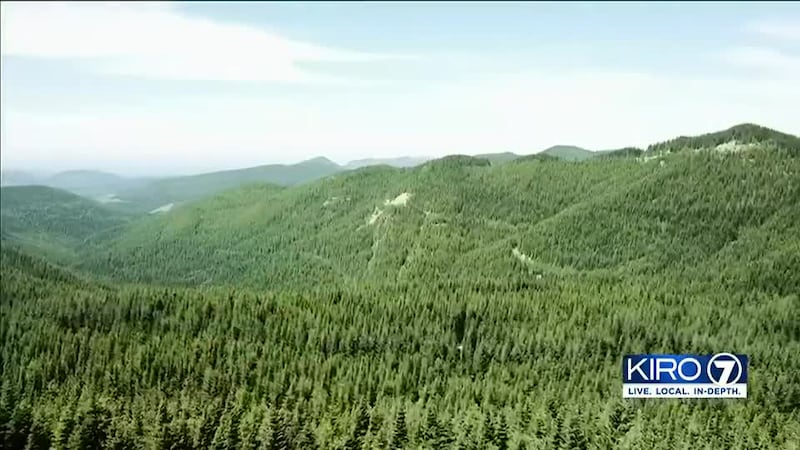It’s a hot day. But deep inside the Nisqually Community Forest, there’s no shortage of shade as my photographer and I work our way around skinny trees and toward a pair of researchers.
A familiar cracking and popping sound echoes around us as we walk over old branches that have fallen to the forest floor before it’s interrupted.
“All right, whatcha got,” calls out Sam Tharpgeorge, a researcher with Resilient Forestry.
Carson, a recent University of Washington graduate, and Tharpgeorge’s work partner, calls out from a distance between two trees and then scribbles down the information.
They’re plotting out trees inside the forest. The pair set up around a tree and begin to calculate the distance from a point they’ve plotted on a map and the trees themselves. The measurements include how wide each tree is, and how tall they are.
“This tree has a small basal scar,” explains Tharpgeorge as Carson types out notes and measurements in a tablet.
We’ve been led out into this area by Jeanette Dorner and Joe Kane -- the current and former executive directors of the Nisqually Land Trust. The measurements are part of a plan that will ultimately end with the nonprofit selling verified carbon credits to companies to raise funds to manage this land for years to come.
Carbon credits are a way for companies to compensate for the damage they do to the environment. Burning fossil fuels directly, or indirectly, adds greenhouse gases to the atmosphere. Having carbon credits is one way that companies attempt to offset their footprint. By measuring the amount of carbon the Nisqually Community Forest takes out of the air, the nonprofit can get verified in the form of “credits,” which can be sold to companies looking to clean up their portfolios as climate change becomes a bigger issue in today’s world.
“Land doesn’t take care of itself,” says Kane. “People think it does. It doesn’t. A carbon market is a great mechanism to cover that kind of cost.”
The goal of the Nisqually Land Trust is to acquire and manage critical lands to benefit the water, wildlife and people in the area.
One of the ways they’re trying to do that in the community forest is to purchase property that was once managed, such as a timber plantation -- to return it to what it once was. Selling carbon credit helps fund it. So does allowing specific trees to be harvested while leaving a majority of the forest intact.
Much of the land that’s been purchased by the land trust in recent years was heavily timbered in the past. Some portions were clear-cut, meaning no trees were left behind.
As the forest has regrown, it came back thick with trees battling for sunlight, blocking the bottom of the forest floor and leaving it nearly impossible for there to be smaller plants, which are needed for animals in the lower levels of the forest. As we drive up through more recently purchase sections of the forest, there are examples of it -- places where little light reaches the ground and tree limbs are dead from competing on top of one another.
Research done in this forest shows that younger, less mature trees require more water. Older trees are the opposite. They release water back into the ground during key parts of the year.
As Kane explains, by encouraging trees to mature more quickly, they can increase the streamflow in the watershed, which will help two types of critically endangered salmon in the region.
“By thinning out these dense forests, it springs the trees we leave behind,” says Kane. “They get older faster. They sequester more carbon. They control more water ... which is beneficial to our endangered species.”
In other words, helping the trees helps the salmon. Dorner goes a step further.
“Many people don’t understand that connection between the health of our community and the health of these wild places,” she says. “The tribes that have lived here since time immemorial -- they understood those connections, and they still understand those connections. They managed the landscape in a different way to make sure these connections were healthy.”
The community forest has been growing too. In the past year, a major land purchase was announced. Between the land trust and the community forest, more than 8,000 acres are now under their control.
There’s hope that by targeting land between a state forest and the national park, they can connect wildlife habitat to ensure the survival of various species -- not just by protecting the land. Also, the plan has been to slowly purchase connected land at higher and higher elevations, creating a path of retreat for animals as the climate changes.
It’s not cheap. And with timber prices soaring, there’s steep competition to get the land.
Dorner says she’s an optimist -- something that’s required in this line of work. It’s a daunting task: saving various species, ensuring a forest survives for a future generation and returning lands to practices that link back to the local Nisqually Tribe, long before Washington existed.
“That’s part of the reason we were created,” she says. “To work with the tribe to help take care of these special places so they can continue their tradition and their way of life.” In the end, that’s what this is about -- saving what we can. After all, climate change, species loss and the health of our streams are all connected in this forest.
Dorner may have a reason for her optimism too. The Nisqually Community Forest doesn’t stand alone anymore. In recent years, grant funding for these types of projects has been increasing and at least 20 similar community forests have now sprung up around Washington state.
©2021 Cox Media Group








